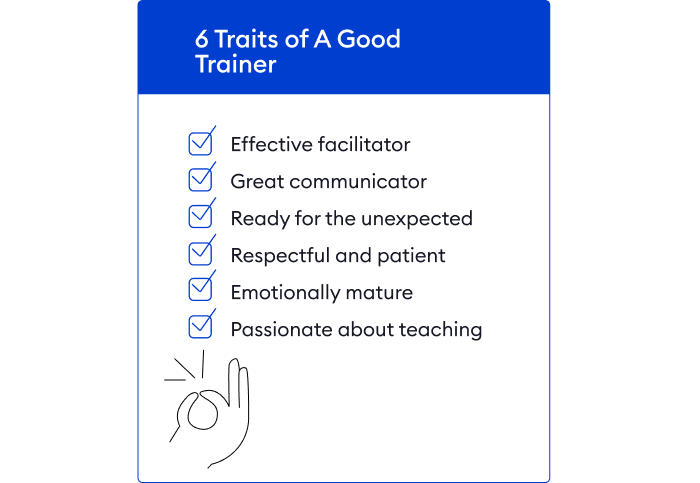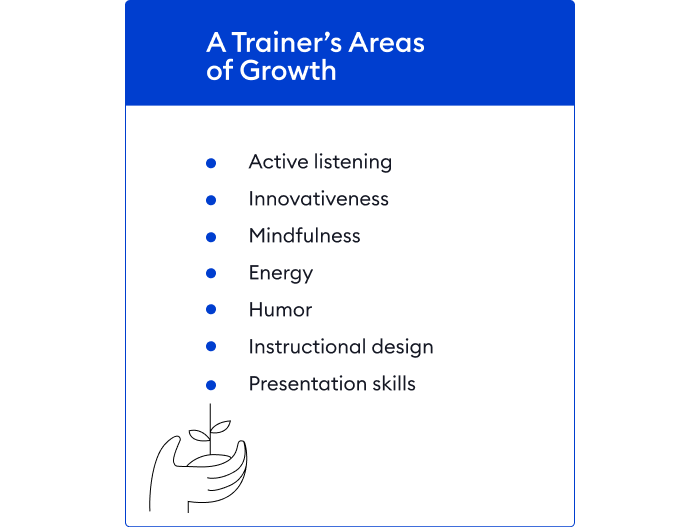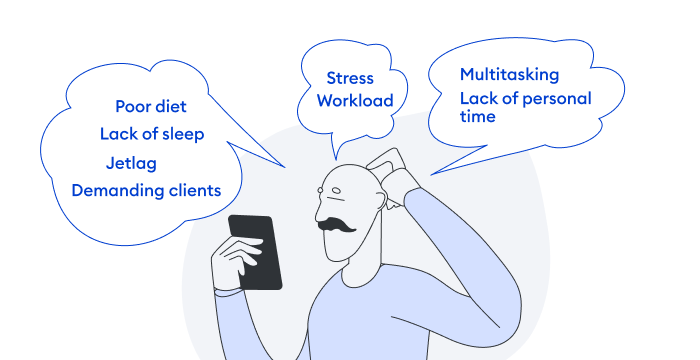Top Qualities of a Good Trainer: Expert Opinion

Whether you conduct online or offline training, its success depends on many factors, like the quality of learning material, an understanding of the audience, relevance to the training and job needs, etc. However, there is a secret ingredient to effective training which is often underestimated – a trainer’s professionalism. This is a set of professional qualities of a good trainer which empowers them to communicate knowledge, support learners, and take responsibility for the result.
In this article, you’ll find insights into how to be a good trainer from these three experts. Read it now or bookmark this material for future reference.

The Core Qualities of a Good Trainer
Before you dive into the six core qualities of an effective corporate trainer and reflect on them with our guests, you can test yourself a little with the checklist below. It contains the traits that we’ll examine in this article. See if you tick all the boxes! It’s OK if some of them are empty so far – feel free to skip to the ones you need and get ideas on how to improve them.

They are effective facilitators
Training is not the same as didactic teaching. It is the learners’ needs, peculiarities, and objectives that trainers have in focus – not giving lectures from textbooks. They guide learners on how to accomplish training objectives, notice group dynamics and learners’ progress, and manage the training event. That’s facilitation.
Roy Pollock, Chief Learning Officer at The 6Ds Company, emphasizes that good trainers are more than just a “sage on the stage,” and that they should operate with a learner-centered approach.
Good facilitation requires trainers listening more than talking, actively engaging learners, and asking good questions so that learners develop their own insights, examples, and analogies.

They are great communicators
Trainers are able to maintain a dialogue with various participants and groups of learners. Their strong communication and interpersonal skills help them attract and maintain attention, break the ice, shift the focus of learners when needed, and be heard by the audience. A successful trainer is also good at nonverbal communication, including body language, which helps to indicate people’s moods, attitudes, and psychological blocks that hinder development.
Dave Potter, Director of Training and Development at Triad Unlimited, points out that a good trainer should possess and master many communication methods:
Assessing the participants’ body language, putting them at ease, and making sure everyone remains engaged requires several types of communication and a great deal of competence in them.

Barbara Davis Robinson, Director of Organizational Development and Learning at WellDyneRX, also stresses the importance of being good listeners for trainers:
Trainers need strong listening skills. Listening is a skill rarely taught but a critical component to the communication process.

They are ready for the unexpected
There are situations when things don’t go as planned, and trainers should be able to handle such situations easily. For example, not all employees may embrace training: they can doubt its relevance and say something like, “What’s the point? I’d be better off going back to work and focusing on my duties.” A good trainer should be able to communicate the value of this particular training to such participants.
Here is another example from Barbara Davis Robinson:
Imagine that you are in a virtual training class, and the technology wasn’t working properly to break learners into groups. What is your Plan B if something you are doing isn’t working? Trainers must be able to juggle and handle on-the-fly issues that arise.

They are respectful and patient
Trainers deal with adults with various backgrounds, lifestyles, education, and different behaviors. There are sprinters and stayers in training, and Barbara Davis Robinson thinks that a good trainer must pay equal attention to both.
Trainers have to balance the content and cater to multiple learning abilities to keep the group focused and on-track so that learning can take place for everyone. How this is projected and communicated in a respectful manner makes the difference in whether the sprinters stay with you or zone out.

Dave Potter confides that when training audiences with different levels of knowledge, he tries to put himself in a participant’s shoes and imagine what kind of material and approach would resonate with them:
I always think of how to transfer knowledge to some person I know who has a similar background. For entry-level training, I think of training my Mom. Mid-level training is teaching my son, who has a technical background. For expert training, such as a conference presentation, I imagine explaining something to my Leadership Team.

They are mature
It may seem that a good trainer is a superhuman who demonstrates supremacy in skills, character traits, knows everything about business or life success, and acts like an unattainable ideal. But, in fact, trainers are people too. They also have strengths and weaknesses. The thing is that a good trainer is a mature person who has confidence, high self-esteem, and doesn’t need to assert themself at the expense of others for the sake of always being right.
You need to demonstrate a level of mastery and confidence if you are to be taken seriously. At the same time, a good trainer must be humble enough to admit that they do not know something, have made a mistake, or that there may be another equally satisfactory approach. A good trainer never tries to “bluff” because if they are caught out, it destroys their credibility and, therefore, effectiveness.

They are passionate about teaching
Genuine enthusiasm is highly desirable for trainers. They should know the ways to maintain a passion for their work, keep their heart and mind open, and deeply care about the results of training. As Roy Pollock puts it, an effective trainer is one who genuinely cares about his or her learners’ success.
As the old saying goes: “They must know that you care before they care what you know.” Teaching is a calling, not just a job.

7 Tips to Be a Good Trainer
Now that we know the core qualities of a good trainer, it’s time to remind ourselves that good trainers are made, not born. Moreover, it’s natural that people who stimulate others to develop can’t help but grow personally and professionally themselves. Below are seven pieces of advice for those who don’t want to rest on their laurels.

1. Be an active listener
Listen, listen, listen. We’ve touched upon the importance of listening skills above, but it is worth a special mention here. Practice active listening: show empathy, look others in the eye, feel the needs of a trainee. Some can regard a trainer’s job as a way to get on a high horse. That’s not true: trainers should be attentive to the needs, strengths, and weaknesses of others.
Do this first: Listen and watch 4 tips from the School of Life project on how to be a good listener.
2. Advocate for change
Trainers recognize the needs of the staff and work on their development. Moreover, they constantly develop their own competencies, embrace new knowledge, and discard obsolete conceptions. To keep driving change, a trainer should find new ways to interact with trainees, devise new approaches, and be generally innovative.
Do this first: Learn more about the latest eLearning trends in corporate training.
3. Think about the now
To be fully present in the process, trainers should practice mindfulness. This is actually a skill to reach a sense of awareness of how you feel, think, communicate, and act in the present moment. The key to this is a trained ability to take a pause (Cara Bradley’s podcast episode ‘Power of the Pause’ says it all).
Do this first: For a mindful pause, you can begin with a simple daily breath technique by William Frey, M.Ed.
4. Cultivate energy
We can imagine what it takes from you as a trainer to put so much into sessions. As in fitness training, you can’t rely only on your willpower, you should stay energetic and feel well. Jonathan Halls who was a leading trainer in the BBC corporation and trained hundreds of media professionals, highlights several reasons for trainer burnout. They are:

Halls thinks that trainers can address these challenges only if they plan their energy. To do this, trainers should schedule time for hobbies, relaxation, physical activity, and learn how to set boundaries.
Do this first: Really, put on your own oxygen mask first and follow Hall’s battle-tested tips from his book “Confessions of a Corporate Trainer: An Insider Tells All.”
5. Use your sense of humor
Humor is the secret ingredient that energizes your audience. It’s all about making training sessions fun and engaging. With humor, you can break the ice and make training content more accessible and understandable. If your training is fun, it increases the attention of your trainees and helps them retain knowledge longer. Just remember to not laugh at someone, but to laugh with someone.
If you’re not sure how to start using humor during synchronous sessions, try some clean jokes for a lighthearted break from intensive training. But it is advisable to research your audience in advance to avoid any jokes that can be perceived as being inappropriately political, ethnic, sexist, racist, or religious.
Do this first: Start practicing humor in learning by giving allusions and references to pop culture: movie quotes, TV shows, or ads. Such jokes are clean and easy to understand. Memes are also good!
6. Be well-versed in ID
eLearning has brought new ways of training via online courses, quizzes, and video tutorials. Now, learning content is as important as the process of knowledge delivery. So, the lines between a trainer’s job and instructional design are becoming increasingly blurred.
A trainer should understand the logic of the instructional design behind what they are asked to teach and should be willing to constructively challenge designs and exercises that do not conform to best practices.

If you’re a trainer, you probably often double as an instructional designer and feel the need to learn how to leverage the advantages of technology. Below is a collection of useful readings to help you on your way:
➹How to Become an Instructional Designer: The Ultimate Guide
➹Instructional Designer Interview Questions and How to Answer Them
➹The Best Books on Instructional Design You Must Read
If you need to come up with an online course on short notice, fortunately, you don’t need to have an IT background or even instructional design experience. There are authoring tools that will empower you to create courses quickly and easily. For example, using iSpring Suite AI, you can make slide-based courses like you always do in PowerPoint, in the same familiar interface, but can enhance them with quizzes, simulations, narrations, etc. within minutes.
Here’s an example of a course you can make yourself:
iSpring Suite also enables trainers to supplement their courses with dialogue simulations and branching scenarios for soft skills training. Here is an example of an industry-based, role-play scenario for customer service.
With dialogue simulations like this one, your trainees can practice new skills according to the framework you’ve created for them, and you can improve this framework continually and revise the script of every dialogue simulation whenever you need to.
Do this first: Download iSpring Suite AI for free now and try to make a quiz or a dialogue simulation.
7. Develop your presentation skills
Since eLearning has become more and more widespread, it may seem that presentation skills are much less relevant, but that’s not true. Presentations are an integral part of a trainer’s job to hold the attention of the audience during a training session, and this does not change over time.
As much as they enhance live training, presentation skills can be really helpful when recording video tutorials, screencasts, presenter-style videos, and other types of training videos. They bring the feeling of presence and engagement into the learning process and improve the entire training experience.
Do this first: Watch a short video by TED’s curator Chris Anderson, in which he talks about the one secret ingredient behind different successful presentations.
Conclusion
We hope you found these qualities of a good trainer valid and the tips inspiring. You can use this article as a checklist to see which areas are your strengths and/or need development as a trainer. You can also try iSpring Suite AI for free to lighten your workload and move your training online easily.
Can you relate to these skills and traits of an effective trainer? Are they a wake-up call for you, or do you know and follow them in your life and work? Please share your thoughts on how to be an effective trainer in the comment section!




